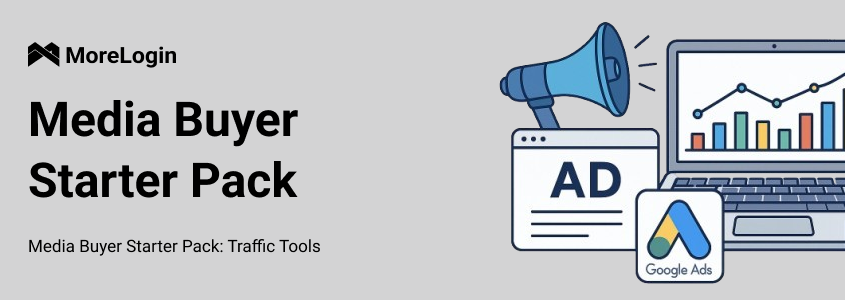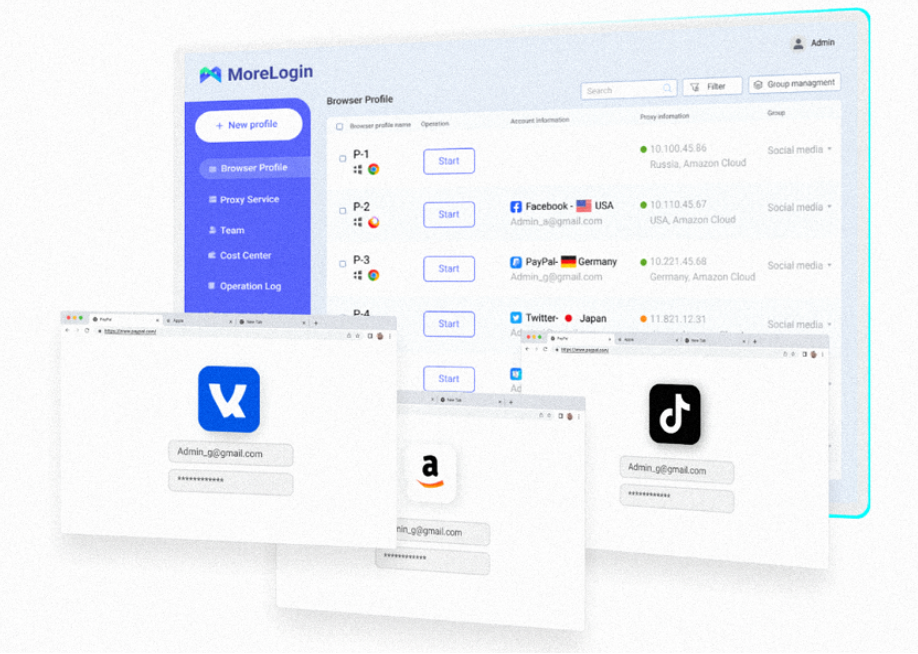
- Product

- Pricing
- Affiliate Program
- Use Cases
- Resource


If you plan to run ads on Facebook, TikTok or Google, the first thing you should think about is your proxy. Even before the account itself. A “good proxy is like your personal key: it’s only yours, you should change it periodically and never lend it to others.”
A proxy is a server intermediary between you and the internet. It hides your real IP and replaces it with another one, creating the appearance to the ad platforms that you are operating from a different region or several countries simultaneously. This enables you to launch campaigns in your target countries, reduce the risk of blocks from ad systems and manage dozens of accounts that all appear as completely independent users.
Popular providers include: Proxyma, Soax, MobileProxy, Astroproxy, AirProxy (mobile & resident proxies) as well as IPRoyal and Ghostealth.
If a proxy masks your physical location, the anti‑detect browser hides your “identity” online. This is a digital mask that changes everything — from device to behaviour. “A regular browser shows who you really are. An anti‑detect browser shows who you want to be: a resident of another country, a user of a different device or even a completely new person.”

In more detail: this browser lets you alter dozens of technical signals which platforms use to identify you. It changes the User‑Agent (e.g., making you appear as Chrome on an iPhone instead of Opera on old Windows), it tweaks Canvas and WebGL fingerprints (graphic device “print”), adjusts language, timezone, fonts, screen resolution and even mouse behaviour.
Its main feature: you can work with many accounts simultaneously — you create dozens of profiles, each totally isolated from the others — and each will appear as a separate live user.
Ad platforms use hundreds of signals to try to detect fraud or rule‑breakers: IP, device, behaviour, login history. If you get “recognized” — a ban is very likely. An anti‑detect browser allows you to appear each time as a “new” person. The platform thinks it’s a different device from a different user.
If you’re operating many accounts on Facebook, TikTok, Google or other networks — or running traffic to grey or high‑risk offers where checks are strict — you simply can’t avoid using it. Without it you’ll lose campaigns faster than you realise.
Popular solutions on the market include: MoreLogin, Dolphin{anty}, Octo, Multilogin.

These services work via subscription; prices depend on number of profiles: basic plans start at around $10/month, advanced ones go to $100+.
Best practice: the anti‑detect works best when used together with a proxy: one masks your IP, the other masks your digital “fingerprint”. Without this combination, the moderations will catch you. Even the most expensive anti‑detect alone does not guarantee invisibility — it’s just a tool. Mistakes in setup or use of “dirty” proxies will nullify its effect. For more realism you should simulate behaviour: click delays, scrolls, mouse movement like a real user.
In affiliate/traffic arbitrage, a domain is not a prestige asset — it’s a consumable resource that burns faster than a proxy.
“A normal website owner buys a domain and renews it every few years. A media‑buyer might buy ten in a week and still feel it’s not enough.”
Platforms like Facebook or Google are very sensitive to redirects, grey schemes and suspect landing pages. Trying to send traffic without a fresh domain or with a “burnt” domain nearly always ends in an instant ban. Therefore buyers often purchase new domains for each campaign, prefer “clean” names, sometimes build chains of redirects and use them along with cloaking so that moderators see one site, and the user sees another.
Why hosting? If you’re sending traffic not to an affiliate’s ready landing, but to your own site, using cloaking or a tracker (e.g., Keitaro or Binom) — hosting is unavoidable. Usually you pick a VPS (virtual private server) where the landing, tracker and masking tools reside. So domain = address, hosting = “house” where your site lives.
Common domain registrars used by buyers: REG.ru, Beget and Timeweb (for mass purchases), Namecheap (for foreign zones), and Regway (for clean .com).
For hosting—buyers often choose Hetzner for cost‑performance, Friendhosting (crypto payment support), or DigitalOcean which is popular among developers and fits trackers well.
The domain + hosting combo is indispensable. But like proxies—they have a limited lifespan: a domain may “burn” after repeated moderation hits; a server may get blacklisted. Experienced buyers always keep backups of resources so they can switch without losing traffic.
Cloaking is a tool that splits your audience and shows different versions of your site to different visitors. Moderators from Facebook or Google see a “clean” version: a landing about sports, healthy habits, organic cosmetics or a wellness blog. A normal user gets the “real” version — with casino, betting, nutra, crypto or other restricted offers.
The principle is simple: the system analyses the visitor across many parameters. It checks IP address (suspicious or not), browser language, cookies, behaviour on the page (a real user moves mouse, scrolls vs a bot), referrer (where the traffic came from), user‑agent and even visit time. If the algorithm identifies a moderator — that user sees the “white” zone. If it’s a normal user—they get redirected to the “black” version with the real offer.
Ad networks forbid or strictly limit promotion of casino, micro‑loans, supplements, crypto and other grey / restricted niches. Attempting to route traffic directly often causes immediate ban of accounts and domains. Cloaking allows you to hide the real landing and access launch opportunities.
Good service providers include: Adspect, NoIpFraud, Keitaro Cloaker, Cloaking.house, Paladium, Redtrack Cloaker. But remember: good cloaking setups cost money — often starting at $100–150/month and can go to $500+ monthly for full support. Many experienced traffickers develop their own cloaks to reduce risk of “being exposed” and to avoid dependence on big generic services.